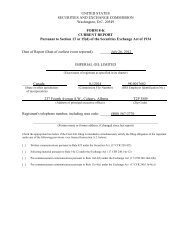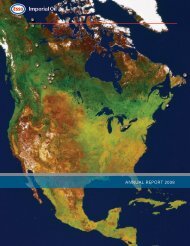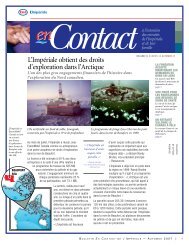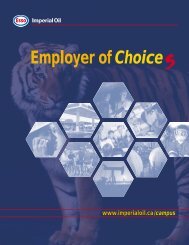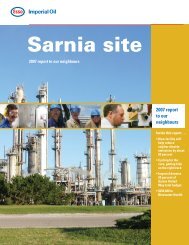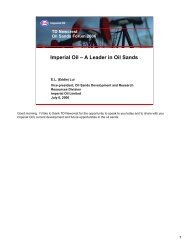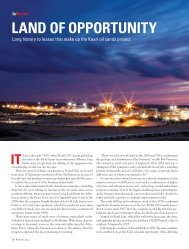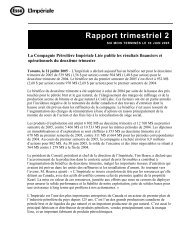FORM 10-K IMPERIAL OIL LIMITED
FORM 10-K IMPERIAL OIL LIMITED
FORM 10-K IMPERIAL OIL LIMITED
Create successful ePaper yourself
Turn your PDF publications into a flip-book with our unique Google optimized e-Paper software.
Maintenance and repair costs, including planned major maintenance, are expensed as incurred. Improvements that increase the capacity or prolong the<br />
service life of an asset are capitalized.<br />
P roduction costs are expensed as incurred. Production involves lifting the oil and gas to the surface and gathering, treating, field processing and field<br />
storage of the oil and gas. The production function normally terminates at the outlet valve on the lease or field production storage tank. Production costs<br />
a re those incurred to operate and maintain the company’s wells and related equipment and facilities. They become part of the cost of oil and gas pro d u c e d .<br />
These costs, sometimes re f e rred to as lifting costs, include such items as labour costs to operate the wells and related equipment; repair and maintenance<br />
costs on the wells and equipment; materials, supplies and energy costs re q u i red to operate the wells and related equipment; and administrative expenses<br />
related to the production activity.<br />
Depreciation and depletion for assets associated with producing properties begin at the time when production commences on a regular basis.<br />
Depreciation for other assets begins when the asset is in place and ready for its intended use. Assets under construction are not depreciated or depleted.<br />
Depreciation and depletion are calculated using the unit-of-production method for producing properties based on proved developed reserves. Depreciation<br />
of other plant and equipment is calculated using the straight-line method, based on the estimated service life of the asset. In general, refineries are<br />
depreciated over 25 years; other major assets, including chemical plants and service stations, are depreciated over 20 years.<br />
Proved oil and gas properties held and used by the company are reviewed for impairment whenever events or changes in circumstances indicate that the<br />
carrying amounts may not be recoverable. Assets are grouped at the lowest level for which there are identifiable cash flows that are largely independent<br />
of the cash flows of other groups of assets.<br />
The company estimates the future undiscounted cash flows of the affected properties to judge the recoverability of carrying amounts. Cash flows used in<br />
impairment evaluations are developed using annually updated corporate plan investment evaluation assumptions for crude oil commodity prices and<br />
foreign-currency exchange rates. Annual volumes are based on individual field production profiles, which are also updated annually. Prices for natural gas<br />
and other products sold under contract are based on corporate plan assumptions that are developed annually and also used for investment evaluation<br />
purposes.<br />
In general, impairment analyses are based on proved reserves. Where probable reserves exist, an appropriately risk-adjusted amount of these reserves<br />
may be included in the impairment evaluation. An asset would be impaired if the undiscounted cash flows were less than its carrying value. Impairments<br />
are measured by the amount by which the asset’s carrying value exceeds its fair value.<br />
Gains or losses on assets sold are included in ”investment and other income” in the consolidated statement of income.<br />
Interest capitalization<br />
Interest costs relating to major capital projects under construction are capitalized as part of property, plant and equipment. Capitalization of interest<br />
ceases when the property, plant and equipment is substantially complete and ready for its intended use.<br />
Goodwill and other intangible assets<br />
Goodwill and intangible assets with indefinite lives are not subject to amortization. These assets are tested for impairment annually or more frequently if<br />
events or circumstances indicate the assets might be impaired. Impairment losses are recognized in current period earnings. The evaluation for<br />
impairment of goodwill is based on a comparison of the carrying values of goodwill and associated operating assets with the estimated present value of<br />
net cash flows from those operating assets.<br />
Intangible assets with determinable useful lives are amortized over the estimated service lives of the assets. Computer software development costs are<br />
amortized over a maximum of 15 years and customer lists are amortized over a maximum of <strong>10</strong> years. The amortization is included in ”depreciation and<br />
depletion” in the consolidated statement of income.<br />
Asset retirement obligations and other environmental liabilities<br />
Legal obligations associated with site restoration on the retirement of assets with determinable useful lives are recognized when they are incurred,<br />
which is typically at the time the assets are installed. The obligations are initially measured at fair value and discounted to present value. A<br />
corresponding amount equal to that of the initial obligation is added to the capitalized costs of the related asset. Over time the discounted asset<br />
retirement obligation amount will be accreted for the change in its present value, and the initial capitalized costs will be depreciated over the useful lives<br />
of the related assets.<br />
No asset retirement obligations are set up for assets with an indeterminate useful life, because such potential obligations cannot be measured since it is<br />
not possible to estimate the settlement dates. Provision for environmental liabilities of these and non-operating assets is made when it is probable that<br />
obligations have been incurred and the amount can be reasonably estimated. These liabilities are not discounted. Asset retirement obligations and other<br />
provisions for environmental liabilities are determined based on engineering estimated costs, taking into account the anticipated method and extent of<br />
remediation consistent with legal requirements, current technology and the possible use of the location.<br />
Foreign-currency translation<br />
Monetary assets and liabilities in foreign currencies have been translated at the rates of exchange prevailing on December 31.<br />
Any exchange gains or losses are recognized in net income.<br />
Financial instruments<br />
The fair values of cash, accounts receivable and current liabilities approximate recorded amounts because of the short period to receipt or payment of<br />
cash. The fair value of the company’s long-term debt is estimated based on quoted market prices for the same or similar issues or on the current rates<br />
offered to the company for debt of the same duration to maturity. The fair values of the company’s other financial instruments, which are mainly longterm<br />
receivables, are estimated primarily by discounting future cash flows, using current rates for similar financial instruments under similar credit risk<br />
and maturity conditions.<br />
F-8



